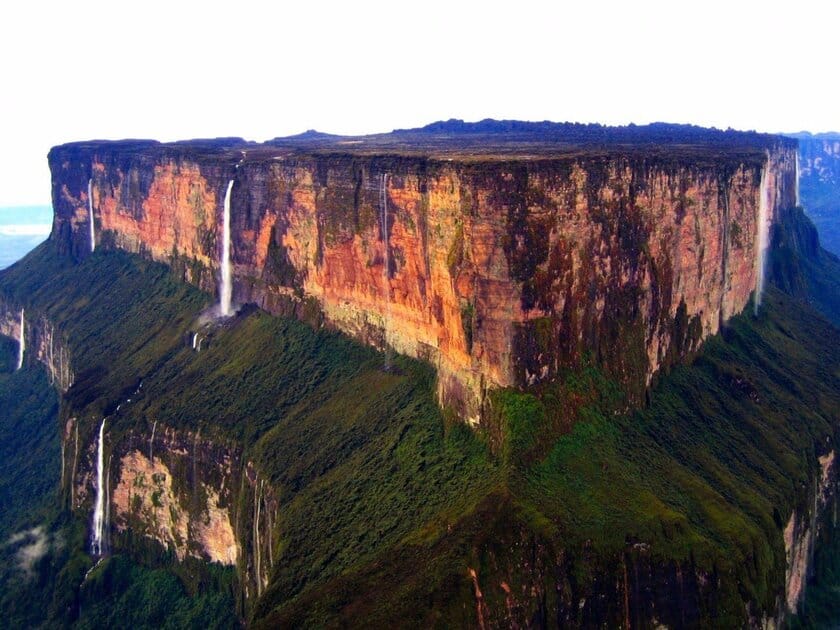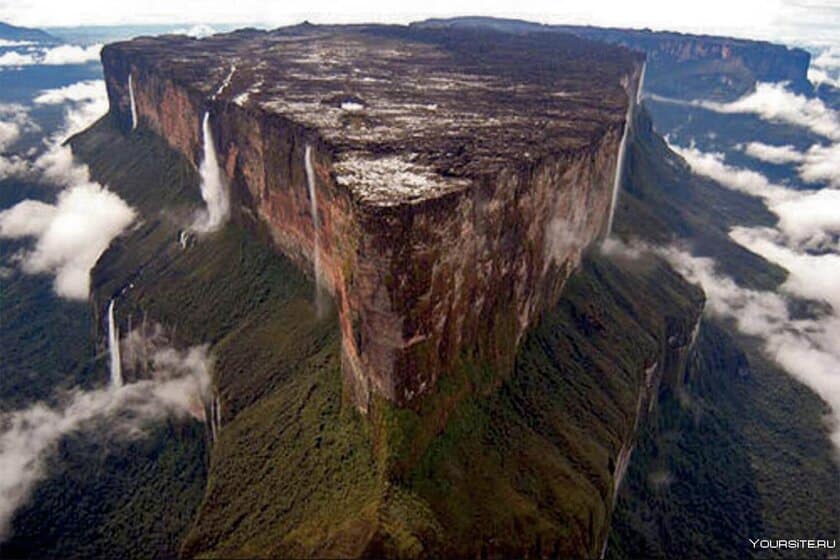
In the heart of Venezuela’s Gran Sabana region, an otherworldly natural wonder awaits: Roraima Tepui. Rising majestically from the surrounding landscapes, this ancient tabletop mountain captivates with its sheer cliffs, unique ecosystem, and mythical allure. Embarking on a journey to Roraima Tepui promises an unforgettable adventure into a world unlike any other.
Geological Marvel:
Roraima Tepui is part of the larger Tepui formation, characterized by its distinct flat top and vertical walls. These tepuis are remnants of an ancient sandstone plateau that have been sculpted over millions of years by wind, water, and geological forces. Roraima Tepui, standing at an impressive height of approximately 2,810 meters (9,220 feet), is the tallest of them all.
Cultural Significance:
Roraima Tepui holds great cultural significance for the indigenous people of the region, particularly the Pemón community. They consider it a sacred place, rich in legends and spirituality. Respect for their traditions and customs when visiting Roraima is crucial to preserving the cultural heritage of the area.
Unique Flora and Fauna:
Ascending Roraima Tepui is like stepping into a world untouched by time. The tepui’s isolated and unique ecosystem has fostered the evolution of numerous endemic plant and animal species. The carnivorous pitcher plants, vibrant orchids, and ancient mosses that adorn the tepui’s summit create a surreal and enchanting landscape. Keep an eye out for endemic species such as the Roraima bush toad, Roraimanum hummingbird, and the elusive Roraima black frog.
The Trekking Experience:
Trekking to the summit of Roraima Tepui in Venezuela is a challenging but immensely rewarding adventure. Multiple routes are available, typically starting from the village of Paraitepui. The journey involves navigating lush rainforests, crossing rivers, and scrambling up steep slopes. Experienced guides are recommended to ensure safety and to provide insights into the local flora, fauna, and folklore.
Magnificent Rock Formations:
One of the highlights of the Roraima Tepui trek is encountering the mesmerizing rock formations that dot the plateau. Known as “La Ventana” (The Window) and “El Abismo” (The Abyss), these natural marvels offer breathtaking panoramic views of the surrounding landscapes. They provide a perfect vantage point to witness the dramatic sunrises and sunsets that cast ever-changing colors on the tepui.
The Lost World:
The mystical ambiance of Roraima Tepui inspired Sir Arthur Conan Doyle’s novel “The Lost World.” Exploring the tepui’s vast and mysterious summit, with its eerie mist-shrouded valleys, hidden caves, and ancient rock formations, transports visitors to a realm that feels untouched by time.
Camping on the Summit:
Camping on the summit of Roraima Tepui in Venezuela is a surreal experience that allows for deeper immersion in the untamed wilderness. With proper camping gear and arrangements, spending a night beneath the stars surrounded by the tepui’s grandeur is an opportunity to connect with nature and marvel at the vastness of the universe.
Responsible Tourism:
Visiting Roraima Tepui comes with the responsibility to preserve its pristine environment and respect the indigenous communities. It is essential to follow the principles of Leave No Trace, carry out all trash, and avoid damaging the delicate flora and fauna. Engaging with the local community and supporting sustainable tourism initiatives contributes to the conservation and preservation of this unique natural treasure for generations to come.
Planning and Preparation:
Before embarking on an adventure to Roraima Tepui, careful planning and preparation are vital. Here are a few essential considerations:
Physical Fitness: Trekking to the summit of Roraima Tepui requires a moderate to high level of physical fitness. Engage in regular exercise and stamina-building activities to prepare for the challenging terrain and long hiking days.
Permits and Guides in Venezuela: Obtain the necessary permits for entering the Canaima National Park, which encompasses Roraima Tepui. Hiring an experienced local guide is highly recommended for safety, navigation, and cultural insights.
Gear and Equipment: Pack appropriate trekking gear, including sturdy hiking boots, rain gear, warm clothing layers, a reliable backpack, camping equipment, and a good-quality sleeping bag. Don’t forget essentials such as sunscreen, insect repellent, a first aid kit, and sufficient drinking water.
Weather and Seasons: Consider the climate and weather patterns of the region when planning your trip. The dry season (December to April) generally offers more stable conditions for trekking, while the wetter months (May to November) bring lush vegetation but increased rainfall and potential muddy trails.
Acclimatization: The high altitude of Roraima Tepui may require acclimatization. Spend a few days in the region to adjust to the altitude before starting the trek, particularly if you have not previously experienced high-altitude environments.
Cultural Exchange and Respect:
Engaging with the Pemón community provides an opportunity to learn about their customs, traditions, and way of life. Respect their beliefs, seek permission before taking photographs, and support local artisans by purchasing their crafts. By fostering cultural exchange and sustainable tourism practices, we can help preserve the cultural heritage of the region.

Reaching Roraima Tepui requires some planning and coordination.
Here are the common routes to get to the starting point of the trek:
Fly to Caracas, Venezuela:
Most international travelers will first need to fly into Simón Bolívar International Airport (CCS) in Caracas, the capital city of Venezuela. Several international airlines offer flights to Caracas from major cities worldwide.
Domestic Flight to Ciudad Bolívar or Santa Elena de Uairén:
From Caracas, you can take a domestic flight to either Ciudad Bolívar or Santa Elena de Uairén. These cities serve as the gateway to Roraima Tepui.
From Ciudad Bolívar, Venezuela:
If you choose to travel via Ciudad Bolívar, you can take a domestic flight to the airport in Canaima, which is the starting point for most Roraima Tepui treks. It’s advisable to arrange this flight in advance through a local tour operator or travel agency.
From Santa Elena de Uairén:
If you opt for Santa Elena de Uairén, it is recommended to hire a local guide or join a guided tour. From Santa Elena, you will typically embark on a multi-day journey by 4×4 vehicle to the indigenous village of Paraitepui, the traditional starting point for the Roraima trek.
Trekking to Roraima Tepui in Venezuela:
Once you reach Paraitepui, the real adventure begins. Engage the services of an experienced guide who can lead you through the challenging terrain and navigate the trail to the summit of Roraima Tepui. The trek usually takes around 6-8 days, depending on the chosen itinerary and the pace of the group.
It’s important to note that the political and social situation in Venezuela can be volatile. It is advisable to stay updated on travel advisories and consult with local tour operators for the most up-to-date information and guidance regarding safety and logistics.
Additionally, it’s essential to obtain the required permits to enter Canaima National Park, which may be arranged through your guide or tour operator.
Remember to pack appropriate gear and supplies for the trek, including sturdy hiking boots, camping equipment, sufficient food and water, and essential items for protection against the elements.
By planning carefully, coordinating with local guides or tour operators, and adhering to safety precautions, you can embark on an incredible journey to Roraima Tepui and immerse yourself in its extraordinary beauty and mystique.


